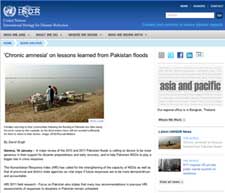January 16, 2012
 Source: UN ISDR
Source: UN ISDR
A major review of the 2010 and 2011 Pakistani floods is calling on donors to be more generous in their support for disaster preparedness and early recovery, and to help Pakistani NGOs to play a bigger role in crisis response.
The Humanitarian Response Index (HRI) has called for the strengthening of the capacity of NGOs as well as that of provincial and district state agencies as vital steps if future responses are to be more demand-driven and accountable.
HRI 2011 field research – Focus on Pakistan also states that many key recommendations in previous HRI assessments of responses to disasters in Pakistan remain unheeded.
According to the Inter-Agency Real Time Evaluation (IA-RTE) which is carried out by DARA, who is a full member of the Active Learning Network for Accountability and Performance in Humanitarian Action (ALNAP), “Pakistani humanitarian actors continue to suffer from ‘chronic amnesia’ by not taking stock of lessons learned from previous evaluations”.
Key among those errors is the failure to recognize that the “2010 floods were probably related to the La Niña phenomenon and can be expected to recur”, states HRI 2011.
The HRI goes on to say that “Pakistan’s vulnerability was again apparent as the 2011 monsoon brought further above average rainfall, resulting in the deaths of some 250 people, more massive displacement and another UN appeal. In a November 2011, four major international NGOs warned that nine million people were at risk of disease.
“In principle, donors recognize the relevance of prevention, risk reduction and preparedness but in reality do not seem to accord them much priority. Disaster risk reduction (DRR) has been discussed by Pakistani authorities and the UN for several years but there is a gap between theory and practice.”
In October 2011, Margareta Wahlström, Special Representative of the UN Secretary-General for Disaster Risk Reduction, visited Pakistan for three days and met with President Asif Ali Zadari who said he would personally, “Champion the process of disaster risk reduction” as his country copes with two successive years of heavy flooding affecting millions of people.
HRI 2011 highlights that “The World Bank has warned that some responses have relied too heavily on rebuilding infrastructure and not enough on better adaptation and preparedness in complementary investments, such as water and flood management, cropping pattern adjustment, rural finance, enhancing capacities of water users groups, and early warning systems”.
Both the HRI 2011 and IA-RTE teams underscore the need to invest seriously in DRR as highlighted by the government, donors, the UN and NGOs. “Emergency responses to disasters will continue to be reactive unless there is greater donor commitment, mapping of stakeholders and pre-defined emergency response mechanisms and stand-by agreements”.
Focus on Pakistan further recommends that donors need to understand how existing vulnerabilities – particularly related to land rights and gender discrimination – contribute to the impact of disasters.
The Humanitarian Response Index (HRI): Focus on is produced by DARA, an independent organization committed to improving the quality and effectiveness of aid for vulnerable populations suffering from conflict, disasters and climate change. The HRI is an independent assessment of donor performance against Good Humanitarian Donorship Principles.
The Active Learning Network for Accountability and Performance in Humanitarian Action (ALNAP) was established in 1997, following the multi-agency evaluation of the Rwanda genocide. It is a collective response by the humanitarian sector, dedicated to improving humanitarian performance through increased learning and accountability.
Share this